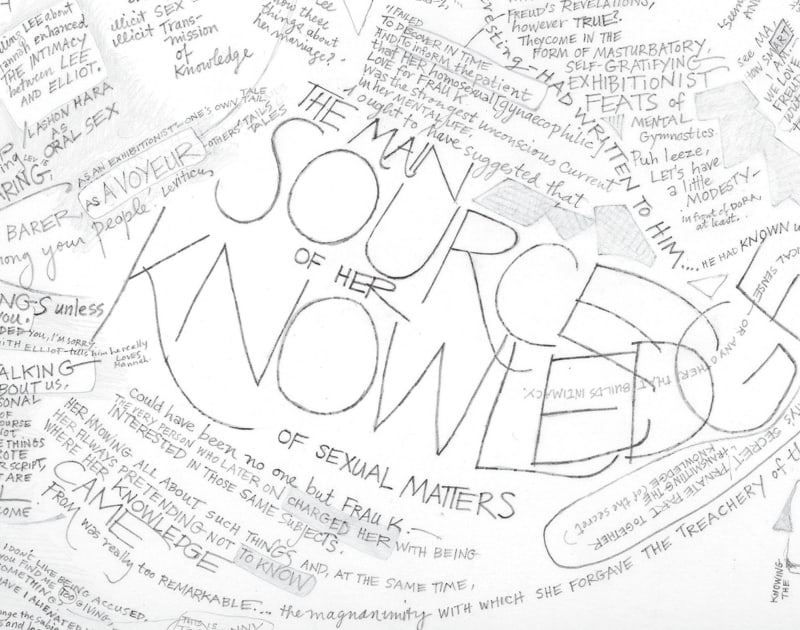This paper will attempt to demonstrate deep and coherent relationships between Henry James’ The Wings of the Dove and Sigmund Freud’s Dora, The Hebrew Bible, and Hamlet. In the process, it will suggest fundamental analogies among writing, weaving, and the communication of neurons in the brain. These observations were first recorded in a series of over forty graphite drawings called Secrets I made in 2000 and 2001. Most of the drawings are about 10 x 13 inches; a few are 8 x 10 inches. They are composed of handwritten quotes from The Wings of the Dove, interspersed with text from the Hebrew Bible, Hamlet, Dora, various other texts, and my own comments. In this paper, I will read two of these drawings.
From the beginning, I saw these drawings as pictures of thinking. I saw the lines of text as neurons and the spaces between them as synaptic gaps. Just as a
neurotransmitter fires across the gap, so do our thoughts and interpretations – yours or mine – link these separate strands. These austere drawings even look like “gray matter”, the myelin sheaths wound around neurons to increase the speed of connection. They look like pathways, especially when seen from an angle. One observer has called them “cities of words,” since the handwritten quotes can resemble buildings and the space between them streets.
Second, I wanted document and explore the parallel constructions, the syntactical similarities I was seeing between Wings and the Hebrew Bible, and also Hamlet. As soon as Densher tells Kate of “his German university” I saw Hamlet at Wittenberg. I will often see a single word in common between works or within works form invisible strands linking the disparate texts. The rabbis have used this method to analyze texts for two millennia. Michael Fishbane calls it “the exegetical imagination.”
In the spring of 2000, I returned from a week in London visiting my daughter, going to the theater, roaming that glorious city, and reading, in the evenings, The Wings of the Dove. I returned to my painting studio, rearranged it, and sat down to think about two issues in this book. As James wrote repeated in his prefaces, I chose a pencil and started writing down quotes. Anyone who has ever taken pencil to paper knows that this medium is a very direct channel for thought.
First, I wanted to trace the intricate path of the secret that killed Milly Theale. “How in the world did he know we’re engaged?” Densher asks Kate about Lord Mark. Lord Mark comes to Venice with, it appears, the sole purpose of telling Milly that Kate and Densher have, all along, been secretly engaged. The effect on Milly is, we guess, to break her trust in Densher, with whom she has fallen in love. She “turns her face to the wall”, gives up her hope for life.
Second, I wanted document and explore the parallel constructions, the syntactical similarities I was seeing between Wings and the Hebrew Bible, and also Hamlet. As soon as Densher tells Kate of “his German university” I saw Hamlet at Wittenberg. I will often see a single word in common between works or within works form invisible strands linking the disparate texts. The rabbis have used this method to analyze texts for two millennia. Michael Fishbane calls it “the exegetical imagination.”
